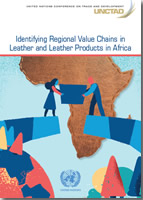
Africa doubled its growth rate in the 2000s as compared with the 1990s; however, growth has not been transformative. In fact, the contribution of the manufacturing sector in total value added has been steadily declining in many countries in the region, indicating de-industrialization.
One of the most important challenges facing Africa is triggering structural transformation in the economies of the region and raising domestic value addition in their exports for generating higher employment. One of the ways for advancing this transformation is to increase competitiveness of the countries in producing and exporting manufactured products using the large base of natural resources available within the region.
The leather and leather products (LLP) industry provides a tremendous opportunity to the region to form regional value chains and add greater value to the region’s exports. At present, the region is the largest source of the basic raw material (i.e. hides and skins) to the leather industry of the world but exports it with little value addition.
This study identifies potential regional value chains for Africa that can be formed in LLP. In this context, the study undertakes the following analyses:
Examines the changing patterns of intraregional and global trade of sub-Saharan Africa, highlighting the importance of intraregional trade in leather and leather products. Inputs and outputs of leather industry are identified and their emerging global as well as intraregional trends are highlighted.
Estimates intraregional trade potential in LLP using gravity model. Trade potential between COMESA, ECOWAS and SACU is estimated. Separate estimates are also made for these subregional blocs. Impact of tariff liberalization on potential intraregional trade is explored.
Estimates export potential in leather as well as leather products of all countries in the three trade blocs (referred to as “region” from now onwards) using a contribution to trade balance (CTB) index and a relative trade balance index describing the position (POS). Based on the two indices, leather inputs and outputs for regional, as well as for global exports are identified for each country.
RVCs differ from global value chains. In RVCs, the end product (finished product) is exported by a country within the region, either globally or regionally. RVCs therefore offer opportunities to the countries in the region to climb up the value chains by using the region to boost their competitiveness and produce and export higher value added products. Well-established RVCs in Africa can also provide an opportunity to the countries in the region to link gainfully into the GVCs and increase their bargaining power with the lead firms.



